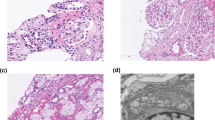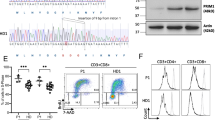Abstract
Background
X-linked Alport syndrome (XLAS) is a progressive, hereditary nephropathy. Although males with XLAS usually develop end-stage renal disease before 30 years of age, some men show a milder phenotype and possess somatic mosaic variants of the type IV collagen α5 gene (COL4A5), with severity depending on variant frequencies. In females, somatic mosaic variants are rarely reported in XLAS, and it is not clear what determines severity.
Methods
Two females with somatic mosaic mutations in COL4A5 with variant frequencies of 17.9 and 22.1% were detected using the next-generation sequencing. One patient only had hematuria. The other, however, had moderate proteinuria, which is a severe phenotype for a female XLAS patient of her age. The molecular mechanisms for the severe phenotype were investigated by examining variant frequencies in urinary sediment cells and X chromosome inactivation patterns, and by looking for modifier variants in podocyte-related genes using the next-generation sequencing.
Results
The severe phenotype patient had a variant frequency of 36.6% in urinary sediment cells, which is not markedly high, nor did she show skewed X chromosome inactivation. However, she did have the heterozygous variant in COL4A3, which can affect severity.
Conclusion
Factors determining severity in female XLAS patients remain unclear. One studied patient with the somatic variant in COL4A5 showed a severe phenotype without skewed X chromosome inactivation, which might be derived from digenic variants in COL4A3 and COL4A5. Further studies are required to determine molecular mechanisms behind female XLAS resulting in the severe phenotype.



Similar content being viewed by others
References
Kashtan CE, Ding J, Gregory M, Gross O, Heidet L, Knebelmann B, Rheault M, Licht C. Alport syndrome research C: clinical practice recommendations for the treatment of Alport syndrome: a statement of the Alport syndrome research collaborative. Pediatr Nephrol. 2013;28(1):5–11.
Jais JP, Knebelmann B, Giatras I, De Marchi M, Rizzoni G, Renieri A, Weber M, Gross O, Netzer KO, Flinter F, et al. X-linked Alport syndrome: natural history in 195 families and genotype- phenotype correlations in males. J Am Soc Nephrol. 2000;11(4):649–57.
Krol RP, Nozu K, Nakanishi K, Iijima K, Takeshima Y, Fu XJ, Nozu Y, Kaito H, Kanda K, Matsuo M, et al. Somatic mosaicism for a mutation of the COL4A5 gene is a cause of mild phenotype male Alport syndrome. Nephrol Dial Transplant. 2008;23(8):2525–30.
Fu XJ, Nozu K, Kaito H, Ninchoji T, Morisada N, Nakanishi K, Yoshikawa N, Ohtsubo H, Matsunoshita N, Kamiyoshi N, et al. Somatic mosaicism and variant frequency detected by next-generation sequencing in X-linked Alport syndrome. Eur J Hum Genet. 2016;24(3):387–91.
Kamiyoshi N, Nozu K, Fu XJ, Morisada N, Nozu Y, Ye MJ, Imafuku A, Miura K, Yamamura T, Minamikawa S, et al. Genetic, Clinical, and Pathologic Backgrounds of Patients with Autosomal Dominant Alport Syndrome. Clin J Am Soc Nephrol. 2016;11(8):1441–9.
International Human Genome Sequencing. C: finishing the euchromatic sequence of the human genome. Nature. 2004;431(7011):931–45.
Allen RC, Zoghbi HY, Moseley AB, Rosenblatt HM, Belmont JW. Methylation of HpaII and HhaI sites near the polymorphic CAG repeat in the human androgen-receptor gene correlates with X chromosome inactivation. Am J Hum Genet. 1992;51(6):1229–39.
Kubota T, Nonoyama S, Tonoki H, Masuno M, Imaizumi K, Kojima M, Wakui K, Shimadzu M, Fukushima Y. A new assay for the analysis of X-chromosome inactivation based on methylation-specific PCR. Hum Genet. 1999;104(1):49–55.
Knebelmann B, Breillat C, Forestier L, Arrondel C, Jacassier D, Giatras I, Drouot L, Deschenes G, Grunfeld JP, Broyer M, et al. Spectrum of mutations in the COL4A5 collagen gene in X-linked Alport syndrome. Am J Hum Genet. 1996;59(6):1221–32.
Kaito H, Nozu K, Fu XJ, Kamioka I, Fujita T, Kanda K, Krol RP, Suminaga R, Ishida A, Iijima K, et al. Detection of a transcript abnormality in mRNA of the SLC12A3 gene extracted from urinary sediment cells of a patient with Gitelman’s syndrome. Pediatr Res. 2007;61(4):502–5.
Nozu K, Iijima K, Kawai K, Nozu Y, Nishida A, Takeshima Y, Fu XJ, Hashimura Y, Kaito H, Nakanishi K, et al. In vivo and in vitro splicing assay of SLC12A1 in an antenatal salt-losing tubulopathy patient with an intronic mutation. Hum Genet. 2009;126(4):533–8.
Lennon R, Stuart HM, Bierzynska A, Randles MJ, Kerr B, Hillman KA, Batra G, Campbell J, Storey H, Flinter FA, et al. Coinheritance of COL4A5 and MYO1E mutations accentuate the severity of kidney disease. Pediatr Nephrol. 2015;30(9):1459–65.
Mencarelli MA, Heidet L, Storey H, van Geel M, Knebelmann B, Fallerini C, Miglietti N, Antonucci MF, Cetta F, Sayer JA, et al. Evidence of digenic inheritance in Alport syndrome. J Med Genet. 2015;52(3):163–74.
Beicht S, Strobl-Wildemann G, Rath S, Wachter O, Alberer M, Kaminsky E, Weber LT, Hinrichsen T, Klein HG, Hoefele J. Next generation sequencing as a useful tool in the diagnostics of mosaicism in Alport syndrome. Gene. 2013;526(2):474–7.
Jais JP, Knebelmann B, Giatras I, De Marchi M, Rizzoni G, Renieri A, Weber M, Gross O, Netzer KO, Flinter F, et al. X-linked Alport syndrome: natural history and genotype-phenotype correlations in girls and women belonging to 195 families: a “European Community Alport Syndrome Concerted Action” study. J Am Soc Nephrol. 2003;14(10):2603–10.
Iijima K, Nozu K, Kamei K, Nakayama M, Ito S, Matsuoka K, Ogata T, Kaito H, Nakanishi K, Matsuo M. Severe Alport syndrome in a young woman caused by a t(X;1)(q22.3;p36.32) balanced translocation. Pediatr Nephrol. 2010;25(10):2165–70.
Guo C, Van Damme B, Vanrenterghem Y, Devriendt K, Cassiman JJ, Marynen P. Severe alport phenotype in a woman with two missense mutations in the same COL4A5 gene and preponderant inactivation of the X chromosome carrying the normal allele. J Clin Invest. 1995;95(4):1832–7.
Okada Y, Sim X, Go MJ, Wu JY, Gu D, Takeuchi F, Takahashi A, Maeda S, Tsunoda T, Chen P, et al. Meta-analysis identifies multiple loci associated with kidney function-related traits in east Asian populations. Nat Genet. 2012;44(8):904–9.
Cheong HI, Park HW, Ha IS, Choi Y. Mutational analysis of COL4A5 gene in Korean Alport syndrome. Pediatr Nephrol. 2000;14(2):117–21.
Acknowledgements
This study was supported by a Grant from the Ministry of Health, Labor and Welfare of Japan for Research on Rare Intractable Diseases in Kidney and Urinary Tract (H24-nanchitou (nan)-ippan-041 to Kazumoto Iijima) in the “Research on Measures for Intractable Diseases” Project; a Grant-in-Aid for Scientific Research (KAKENHI) from the Ministry of Education, Culture, Sports, Science and Technology of Japan (Subject ID: 25893131 to Kandai Nozu and 26293203 to Kazumoto Iijima).
Author information
Authors and Affiliations
Corresponding author
Ethics declarations
Conflict of interest
Kandai Nozu received lecture fees from Novartis Pharma K.K. and Taisho Pharm. Co. Kazumoto Iijima has received grants from Daiichi Sankyo Co., Ltd., Japan Blood Product Organization, Miyarisan Pharmaceutical Co., Ltd., AbbVie LLC, CSL Behring, JCR Pharmaceuticals Co., Ltd., Teijin Pharma Ltd., Novo Nordisk Pharma Ltd., AIR WATER MEDICAL Inc., Astellas Pharma Inc., Takeda Pharmaceutical Company Ltd. and Taisho Toyama Pharmaceutical Co., Ltd. and lecture fees from Meiji Seika Pharma Co., Ltd., Novartis Pharma K.K., Zenyaku Kogyo Co., Ltd., Chugai Pharmaceutical Co., Ltd., Daiichi Sankyo, Co., Ltd., Springer Japan, Asahi Kasei Pharma Corp, Boehringer Ingelheim, Medical Review Co., Ltd., NIKKEI RADIO BROADCASTING CORPORATION, Japan Blood Product Organization and CSL Behring and manuscript fees from Chugai Pharmaceutical Co., Ltd., and consulting fees from Zenyaku Kogyo Co., Ltd., Chugai Pharmaceutical Co., Ltd., Astellas Pharma Inc., Takeda Pharmaceutical Company Ltd., Ono Pharmaceutical Co., Ltd. and Kyowa Hakko Kirin Co. Ltd.
Ethical consideration and informed consent
All procedures performed in studies involving human participants were in accordance with the ethical standards of the Institutional Review Board of Kobe University School of Medicine (IRB approval number 301) and with the 1964 Helsinki declaration and its later amendments or comparable ethical standards. Informed consent was obtained from all individual participants included in the study.
About this article
Cite this article
Yokota, K., Nozu, K., Minamikawa, S. et al. Female X-linked Alport syndrome with somatic mosaicism. Clin Exp Nephrol 21, 877–883 (2017). https://doi.org/10.1007/s10157-016-1352-y
Received:
Accepted:
Published:
Issue Date:
DOI: https://doi.org/10.1007/s10157-016-1352-y




